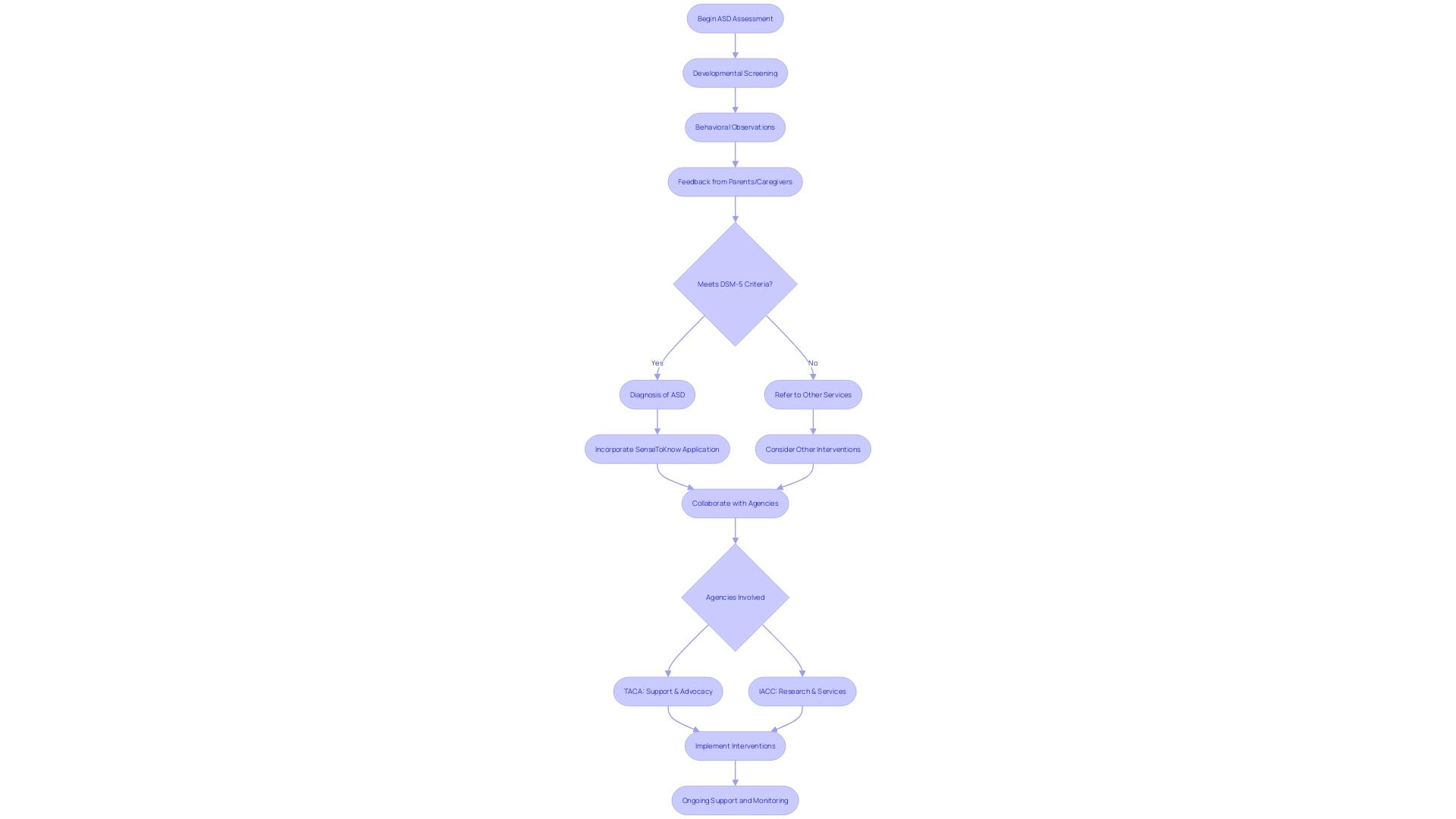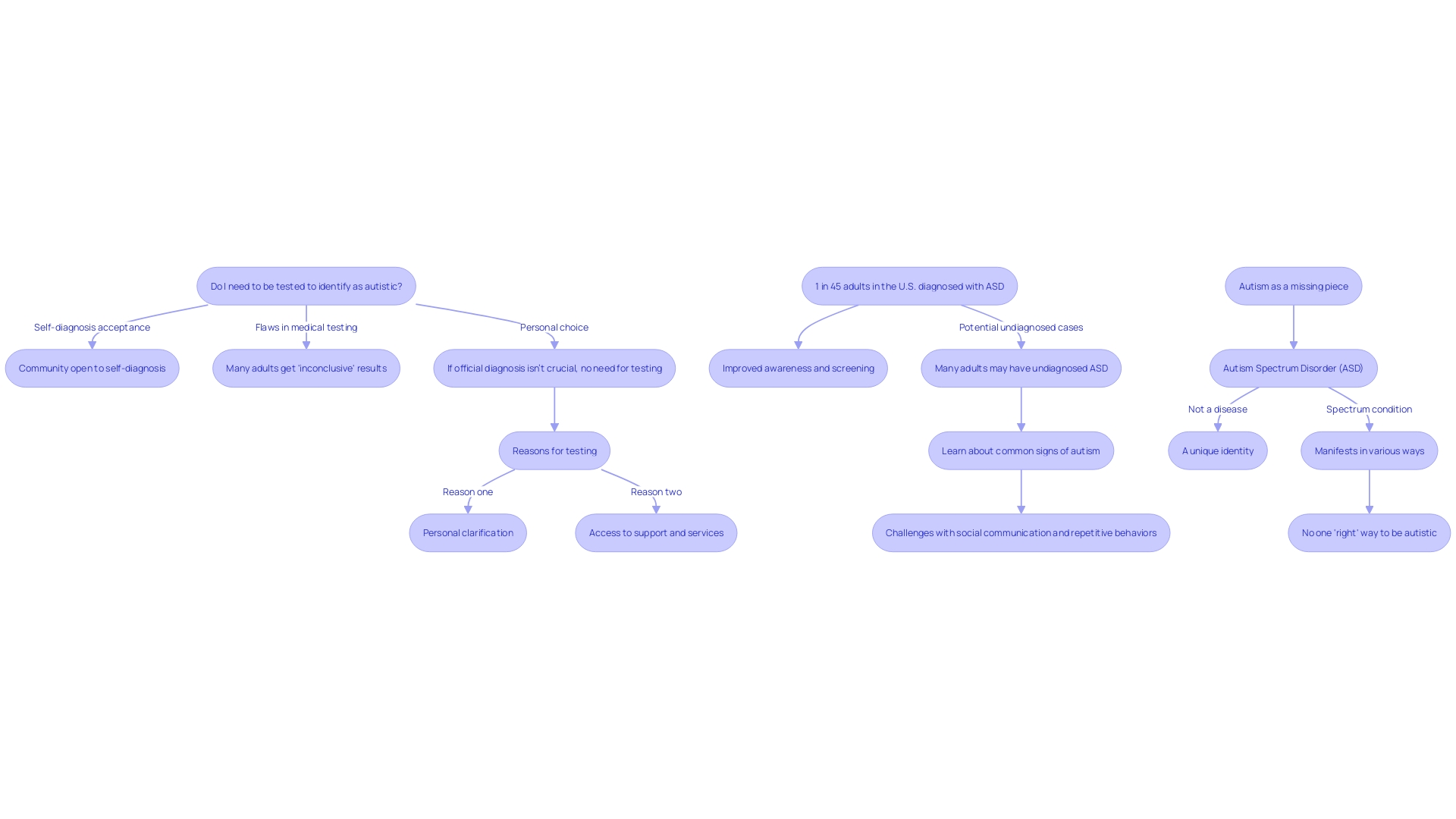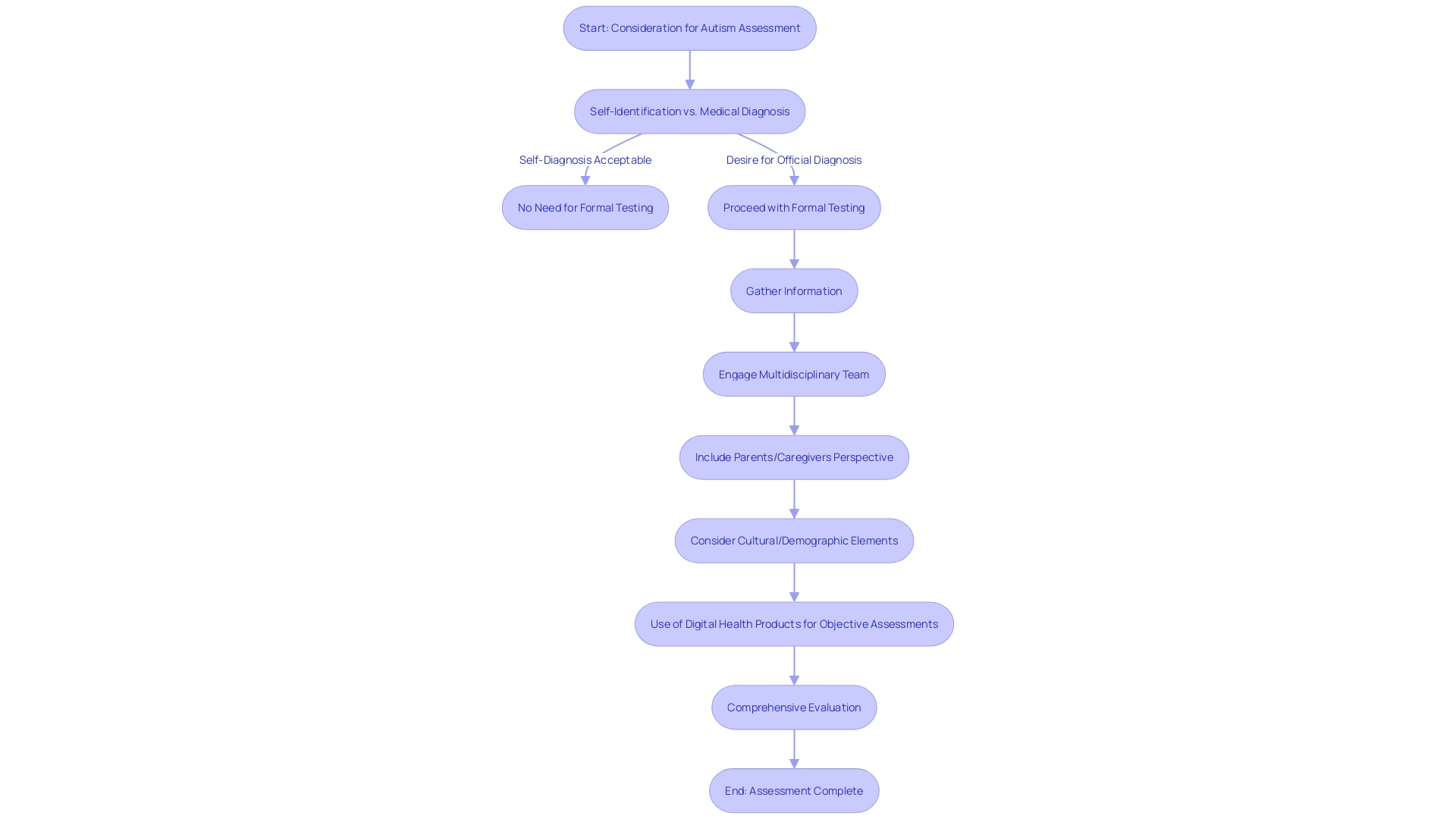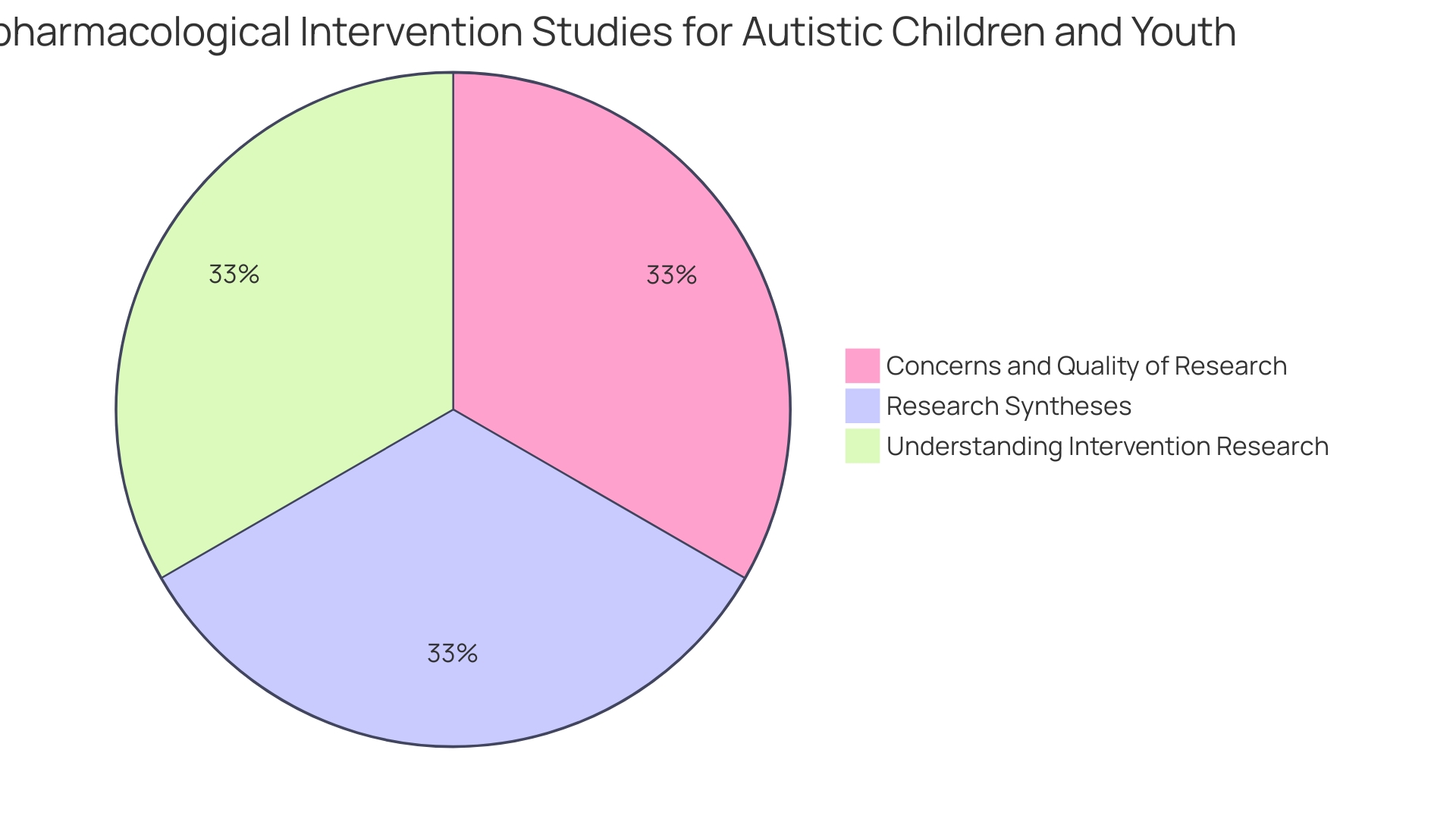Introduction
Understanding the unique characteristics and needs of individuals on the autism spectrum is essential for providing tailored support and interventions. A precise autism assessment is not just about diagnosis but about paving the way for effective strategies that promote the individual's development, communication, and overall well-being. This article explores the importance of accurate autism assessment and the role of technology in enhancing the diagnostic process.
It also discusses the types of assessment tools available, the considerations for choosing the right tools, and the characteristics of effective assessments. Additionally, the article examines the comprehensive evaluation and diagnosis process, the creation of treatment plans based on assessment results, and future directions in autism assessment and diagnosis. By providing guidance and resources, this article empowers the Parent Advocate audience to navigate challenges and ensure the well-being of their children on the autism spectrum.
Importance of Accurate Autism Assessment
Understanding the distinct traits and requirements of individuals on the spectrum is crucial for offering personalized support and interventions. A precise assessment for individuals with this developmental condition is not just about diagnosis but about paving the way for effective strategies that promote their development, communication, and overall well-being. For example, the groundbreaking SenseToKnow app, created by Duke professors Geraldine Dawson and Guillermo Sapiro, showcases the future of evaluation for individuals with autism. By utilizing tablet-based movies that evoke a broad range of behaviors associated with individuals on the autism spectrum, this device captures facial expressions, head movements, social attention, and even motor skills through an interactive bubble-popping game. Computer vision analysis then quantifies these responses, with an AI algorithm providing diagnostic classifications and confidence levels.
Diagnosing ASD spectrum disorder traditionally relies on parental insights and professional observations, guided by the DSM-5 criteria. Although there are many options available for evaluating ASD in young children, it is not recommended to depend solely on one approach. Instead, a multidimensional approach is advocated, sometimes involving referrals to specialists. This meticulous process is vital as it mirrors the complexity and variability inherent in individuals with autism spectrum disorder, as noted by Geraldine Dawson of the Duke Center for Autism and Brain Development.
Echoing the importance of early and accurate diagnosis is The Autism Community in Action (TACA), which emphasizes that earlier behavioral therapy is linked to better outcomes. With innovative diagnostic tools like NeuroQure's technology, the journey to an ASD diagnosis can be shortened from years to weeks, especially for families with a higher risk. Moreover, a research conducted by the Karolinska Institutet presented the AutMedAI model that, through analyzing information from the SPARK database, could detect approximately 80% of children with ASD before 24 months of age.
Supporting these technologies and methodologies is the practice that embraces neurodiversity, acknowledging autism as a natural brain variation and emphasizing the significance of nurturing environments instead of perceiving it as a condition requiring treatment. This perspective is vital for ensuring equitable and constructive support for autistic individuals, allowing them to thrive in their own unique ways. The collective endeavor, involving contributions from a varied range of stakeholders, is crucial for promoting an encompassing understanding that covers the requirements of individuals on the spectrum with deep difficulties. Such inclusivity ensures that the diagnostic process not only identifies ASD but also paves the way for a life of supported and celebrated neurodiversity.
Types of Autism Assessment Tools
Experts in the area of ASD implement a comprehensive approach for assessment, relying on a blend of developmental screening methods, thorough behavioral observations, and feedback from parents or caregivers to guide diagnosis and intervention strategies. The Diagnostic and Statistical Manual, Fifth Edition (DSM-5) published by the American Psychiatric Association, delineates standardized criteria for ASD diagnosis, ensuring professionals have a consistent framework for assessment.
Innovative resources such as the SenseToKnow application, which tracks a child's eye movements and motor skills during interactive activities, leverage artificial intelligence to predict ASD likelihood. This technology represents the forefront of research aiming to capture the diverse behaviors associated with the condition, underscoring the complexity and variability inherent to it.
The early identification of ASD is crucial, as interventions like behavioral therapy, when initiated promptly, can significantly enhance outcomes. Agencies like The Autism Community in Action (TACA) and the Interagency Autism Coordinating Committee (IACC) work together to connect federal initiatives and community requirements, highlighting the importance of accessible, efficient diagnostic resources. Such advancements could shorten the diagnostic journey, which can often be an arduous process spanning years, to just weeks after birth, particularly for families with a higher ASD risk.
Through the lens of experts and researchers, the quest for understanding ASD in adulthood remains largely uncharted territory, highlighting the persistent need for lifelong support and services. With the prevalence of autism diagnoses in individuals now estimated at 1 in 36, the call for comprehensive, early diagnostic measures has never been more pronounced. The interaction of professional knowledge, parental understanding, and advanced diagnostic equipment is crucial in navigating the complexities of autism assessment, with the ultimate aim of facilitating timely and personalized assistance for individuals with ASD.

Screening Tools for Autism
Autism spectrum disorder (ASD) is a condition that can have far-reaching effects on an individual's communication, behavior, and social interactions. The process of determining whether a child may have ASD often starts with screening methods, which act as an initial checkpoint to evaluate the potential existence of autism-related traits. These assessment instruments are not diagnostic, but they are pivotal—they act as a beacon, guiding caregivers and healthcare professionals by flagging the need for more in-depth evaluation.
Screening for ASD can transpire in various settings and can be conducted by a multitude of individuals, including parents, educators, and medical professionals. The instruments are designed to be simple and fast, often including surveys or observations that identify behaviors and developmental milestones. The importance of these instruments cannot be exaggerated. Research indicates that early intervention, such as behavioral therapy, can substantially improve outcomes for children with a developmental disorder. In fact, organizations like The Autism Community in Action (TACA) and initiatives from experts at Duke University highlight the dramatic difference early and accurate detection can make.
In the realm of preventative care, the US Preventive Services Task Force (USPSTF) underscores the importance of evidence-based recommendations that are devoid of cost consideration but rich in clinical benefit analysis. This method is reflected in the autism screening process, where the importance of the instruments is crucial. Criteria such as the ability to detect a significant portion of cases, cost-effectiveness, user-friendliness, and the reliability of results are the cornerstones of high-quality screening tools, according to research by Johnson et al. (2009).
Beyond the technicalities, the USPSTF also acknowledges the intricate web of factors that contribute to health risks, such as race, ethnicity, and gender—recognizing them as social constructs with real implications on healthcare outcomes. This dedication to fairness is crucial in the screening procedure, as it guarantees that every individual, regardless of their background, has access to the resources needed for an impartial evaluation and the chance for prompt intervention.

Diagnostic Tools for Autism
Accurately diagnosing autism spectrum disorder (ASD) is critical, as it opens the door to tailored support and intervention. The process involves a blend of methodologies, none of which should stand alone as the sole diagnostic measure. It starts with thorough input from caregivers on the developmental history of a young individual and a healthcare professional's observations of the individual's behavior. The DSM-5 provides a framework for evaluating ASD, but it's the combination of resources that provide a well-rounded perspective.
Experts, including neurodevelopmental pediatricians and pediatric neurologists, undertake a detailed evaluation of various developmental domains to pinpoint an individual's unique profile, including strengths, difficulties, and needs. The SenseToKnow screening exemplifies innovation in this field, utilizing tablet sensors and AI to analyze an individual's response to stimuli, evaluating a wide range of behaviors indicative of autism.
Furthermore, the latest progress in machine learning has resulted in the creation of the AutMedAI model, which, through the examination of particular parameters, can detect ASD with approximately 80% accuracy in individuals under the age of two. This indicates a future in which diagnostic tools can effectively identify ASD much earlier, greatly enhancing the path for impacted individuals.
ASD diagnosis is not just about labeling; it's about understanding the individual as a whole. The Autism Community in Action (TACA) highlights that early and accurate diagnosis followed by prompt intervention can vastly improve outcomes. It's a race for fairness and equity, ensuring that every child, regardless of neurodiversity, can participate meaningfully in life's domains, supported by resources that nurture their development and well-being.
Key Diagnostic Tools: ADOS, ADI-R, CARS, and GARS
Autism spectrum disorder (ASD) presents a unique set of challenges in diagnosis due to its heterogeneous nature, with individuals displaying a vast range of behaviors and developmental variations. Recognizing the signs of autism early is pivotal, as interventions are most effective during the brain's formative years. Traditional diagnostic tools, such as the Autism Diagnostic Observation Schedule (ADOS) and the Autism Diagnostic Interview-Revised (ADI-R), leverage structured assessments to evaluate communication, social interaction, and repetitive behaviors. However, these approaches, while crucial, also rely on the subjective assessment of clinicians and can result in extended diagnosis timelines, delaying vital assistance for youngsters and their families.
In response to these challenges, new technologies are augmenting diagnostic processes to achieve greater accuracy and efficiency. Eye-tracking technology, for example, provides objective data on how children process visual information. Studies reveal that autistic individuals often focus on non-social elements, such as objects or patterns, rather than people's faces. This understanding of early behavioral indicators can enhance the recognition of the condition, providing a measurable measure that complements conventional evaluations.
Moreover, the advancement of machine learning models, like the 'AutMedAI' created from the SPARK database, demonstrates the potential of data-driven methods in the field of diagnosing individuals with autism. By analyzing a diverse set of parameters, this model has demonstrated an approximately 80% accuracy rate in identifying individuals with ASD under two years of age. It signifies a leap forward in early detection, crucial for initiating timely interventions.
The month dedicated to raising awareness about ASD emphasizes the importance of improving diagnostic tools to tackle the worldwide health challenge presented by ASD. With about 1 in 160 children worldwide diagnosed with ASD, and rates as high as 1 in 68 in the United States, the demand for more precise and rapid diagnostic methods is evident. Organizations like The Autism Community in Action (TACA) and NeuroQure are at the forefront of this mission, aiming to reduce the arduous journey to diagnosis that many families face.
The Interagency Autism Coordinating Committee (IACC) plays a significant role in this landscape by enhancing coordination and communication across federal agencies and partnering with the ASD community. Comprising diverse stakeholders, the IACC's independent advisory body crafts recommendations that reflect a broad spectrum of expertise and viewpoints, furthering the collective effort to support individuals with ASD and their families.
Characteristics of Effective Autism Assessments
When it comes to autism assessments, precision and a thorough approach are paramount. The process involves an integration of information from a wide array of resources and methods, ensuring a comprehensive evaluation is achieved. In line with the American Psychiatric Association's Diagnostic and Statistical Manual, Fifth Edition (DSM-5), experts agree that no single tool should be the sole basis for a diagnosis. With a multidisciplinary team at the helm, professionals from various specialties come together to provide a nuanced perspective of the individual, encompassing social, communicative, and behavioral aspects.
The involvement of parents and caregivers' perspectives is crucial, as their thorough explanations of a young person's growth contribute greatly to the evaluation procedure. Alongside professional observations, these accounts form the backbone of an effective diagnosis, as per statistics highlighting the dual reliance on both parents' narratives and expert evaluations. The IACC emphasizes the importance of collaboration across disciplines and with family members to enhance understanding and progress in autism services.
Considering cultural and demographic elements is also essential, ensuring a sensitive evaluation process that honors the individual's background. Dr. David (Dan) R. Offord's notion of a 'fair race' for children resonates deeply here, underscoring the importance of equitable and supportive participation for all children, particularly those at high risk of social exclusion, such as autistic individuals with additional emotional and behavioral challenges.
Recent advancements in digital health products, including mobile apps, offer promising supplementary resources to traditional assessments. These innovative solutions can gather ecological data from the individual's home environment, potentially aiding clinicians in the diagnostic phase. They represent a step towards more objective, data-driven assessments that can mitigate the risks of subjective clinician interpretation and misdiagnosis, while also addressing diagnostic delays that can exacerbate comorbidities.

Considerations for Choosing the Right Assessment Tools
Choosing the appropriate evaluation instruments for individuals with ASD is a nuanced process that requires careful consideration of the person's specific characteristics and the context of the evaluation. A universal approach is not appropriate; each instrument must be selected based on the child's age, developmental stage, and distinct behavioral patterns. It's also essential to consider the family's cultural and linguistic background to ensure the process is respectful and relevant. Given that autism is a condition that varies across a spectrum, it is important for the resources to consider the wide range of manifestations, including difficulties in communication and repetitive actions. Assessment should not just be about diagnosis but also about understanding the individual's strengths and areas for support. Professionals need to have the appropriate expertise to interpret the results accurately, providing a diagnosis that can lead to early and effective interventions. As organizations like The Autism Community in Action (TACA) advocate, early treatment can lead to improved outcomes. Additionally, cutting-edge resources like the Infant and Toddler Toolbox (NBT) are being created to offer thorough assessments utilizing state-of-the-art techniques such as eye-tracking. This progress in assessment tools is crucial as it's estimated that 1 in 36 individuals may be on the spectrum of autism, and early identification is key to accessing vital resources. With precise and personalized assessment, we can reduce the path to diagnosis and intervention, ensuring each individual receives the support they require to flourish.
The Role of Technology in Autism Assessment
The convergence of technology and healthcare is transforming how we approach ASD assessments. A noteworthy example is the digital-assurance process, a rigorous evaluation that ensures new technologies meet stringent standards of security, appropriateness, and compliance. This careful method is demonstrated by undertakings such as SenseToKnow, an application created by educators from Duke University, which employs AI to examine children's behavioral reactions to visual stimuli on a tablet to aid in diagnosing developmental disorders.
The app records and analyzes a spectrum of behaviors, including eye movement, facial expressions, and motor skills, which are early indicators of ASD. Integrating these behaviors into digital phenotypes, the app's AI algorithm can distinguish autistic versus non-autistic patterns, providing a quantitative confidence level for the diagnosis. This approach aligns with the requirement for precise, effective evaluation procedures, especially for identifying indications of developmental disorder in early childhood. The technology not only improves diagnostic accuracy but also aids in detecting at an earlier stage, making use of the brain's adaptability in young individuals to mitigate possible impairments.
Besides SenseToKnow, AI has been employed in alternative creative manners, like examining images of kids' retinas to assess for developmental disorder. Researchers in Korea employed AI to evaluate retinal images from 958 children, discerning patterns that correlate with ASD. These advancements demonstrate the power of technology in transforming ASD assessments, offering objective, standardized, and nuanced insights that elevate the quality of diagnosis and intervention.
Comprehensive Evaluation and Diagnosis Process
The process of comprehending an individual's distinctive profile on the spectrum of neurological differences commonly starts with a comprehensive assessment. This process meticulously gathers insights from various angles, factoring in developmental history, observed behaviors, social interactions, and communication skills. A blend of interviews, direct observations, and standardized instruments, such as the Vineland Adaptive Behavior Scales, offers a tapestry of information that, when woven together, provides a clear picture of a person's capabilities and challenges. Collaborating closely with families and educational teams ensures a holistic view, reflecting both the individual's potential and the areas where support could unlock further growth.
The value of such thorough assessments is echoed by the autistic and neurodivergent community's stance on self-identification. While some opt for official diagnoses, others find solace in self-diagnosis, particularly when formal assessments yield inconclusive results or are inaccessible. The significance of fairness in opportunities, as expressed by the late Dr. David (Dan) R. Offord, strongly echoes in this context, highlighting the requirement for equitable and supportive circumstances for all individuals, including those who have autism, to flourish.
In line with the sentiment that 'Autism is treatable,' as stated by The Autism Community in Action (TACA), early and accurate diagnosis is crucial. The quest for improved diagnostic tools is ongoing, with initiatives like NeuroQure aiming to revolutionize early detection and intervention. With research indicating that 1 in 160 individuals globally are on the autism spectrum, the urgency for efficient, accessible, and equitable diagnostic practices is evident. The interdisciplinary approach, combining medical, educational, and family perspectives, forms the cornerstone of a fair and inclusive society that supports every individual's journey, recognizing their inherent value and fostering their fullest participation in life.

Creating a Treatment Plan Based on Assessment Results
Thorough evaluations for individuals with autism spectrum disorder lay the groundwork for tailored treatment plans that target the distinctive strengths and challenges of each person. These plans are multidimensional, often encompassing behavioral interventions, speech therapy, occupational therapy, and social skills training. Each component is informed by in-depth assessments, gearing towards optimizing the individual's ability to navigate various environments and enhancing their independence. For instance, pediatric occupational therapist Kara, from Florida, emphasizes the significance of fostering autonomy through therapies that encourage self-reliance, which she found critical in the development and independence of individuals with autism spectrum disorder. This reflects the feelings of the late Dr. David (Dan) R. Offord, who emphasized the significance of fair and supportive involvement in the lives of individuals with disabilities, which is crucial for their mental well-being and overall growth.
Furthermore, the Autism Community in Action (TACA) suggests that early intervention, such as behavioral therapy informed by accurate diagnosis, leads to better outcomes. This is supported by the efforts of NeuroQure, aiming to shorten the diagnostic journey for ASD, thereby facilitating timely interventions. As evidenced by the Kevin and Avonte Program, targeted efforts to address specific challenges, such as wandering, can lead to significant improvements in safety and well-being for individuals with autism. This is crucial, as almost twenty percent of individuals insured by Medicaid, which includes most individuals on the autism spectrum and many young individuals on the autism spectrum, depend on state programs for access to essential care and services. Indeed, the effectiveness of these treatments is bolstered by the insight gained from thorough assessments, ensuring that each plan is as unique as the individual it is designed to support.
Future Directions in Autism Assessment and Diagnosis
Autism spectrum disorder (ASD) diagnosis and assessment are areas of intense focus and innovation, with advancements aimed at enhancing early detection and tailoring interventions to individual needs. Technological innovations, such as the Sense to know app, use tablet-based activities and computer vision analysis to identify behavioral markers associated with ASD. This app, created by Duke professors Geraldine Dawson and Guillermo Sapiro, marks a notable advancement in enhancing accessibility and reducing invasiveness of diagnostic methods.
The incorporation of machine learning is also transforming the field, with systems like AutMedAI analyzing a combination of behavioral parameters to identify children with developmental disorder with nearly 80% accuracy before the age of two. Such tools are instrumental in initiating early behavioral therapy, which is linked to improved outcomes.
Furthermore, the inclusion of biomarkers and genetic testing in the diagnostic process is on the rise, paving the way for more precise and personalized approaches to understanding and supporting individuals with ASD. This is echoed by the work of federal agencies and committees like the IACC, which emphasize collaboration and inclusivity in autism research and services.
In line with the urgency for timely and accurate diagnosis highlighted by organizations such as The Autism Community in Action (TACA), the pursuit of culturally sensitive assessment methods ensures that diverse populations receive equitable care and support. These efforts reflect a commitment to addressing the unique challenges faced by individuals with ASD and their families, shortening the diagnostic journey and fostering a more inclusive society.

Conclusion
Accurate autism assessment is crucial for providing tailored support and interventions that promote the well-being and development of individuals on the autism spectrum. Technology, such as the SenseToKnow app and machine learning models like AutMedAI, enhances the diagnostic process by offering objective insights and facilitating early detection. Effective assessments integrate information from various tools, consider input from parents and caregivers, and address cultural and demographic factors.
Collaborating with families and educational teams ensures a holistic view of the individual's potential and areas for support. Assessment results form the foundation for personalized treatment plans, including behavioral therapy, speech therapy, and occupational therapy, which lead to better outcomes and improved safety and well-being. The future of autism assessment focuses on early detection and individualized interventions.
Technological advancements and the integration of biomarkers and genetic testing offer promising opportunities for more precise and accessible diagnostic methods. Accurate autism assessment empowers Parent Advocates to navigate challenges and ensure the well-being of their children on the autism spectrum.




